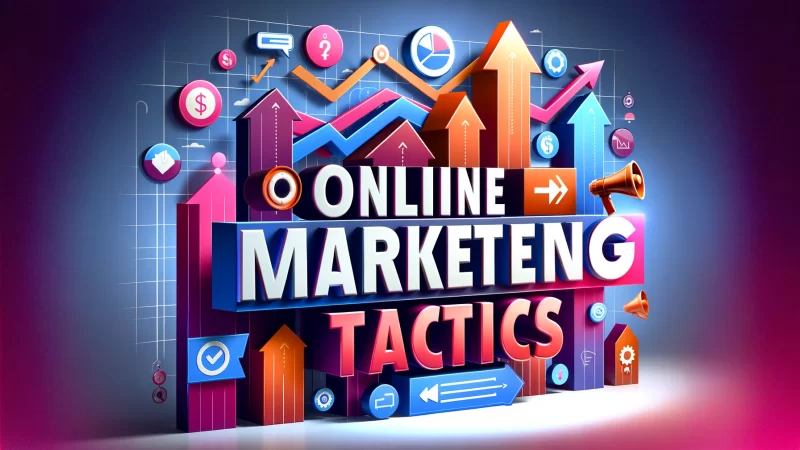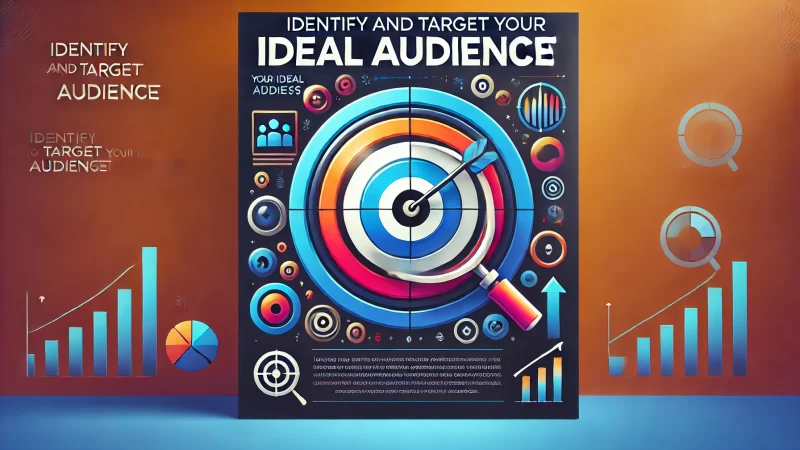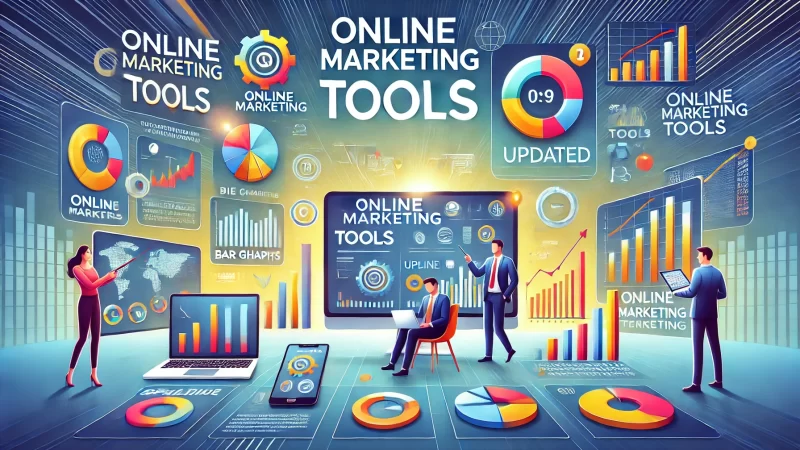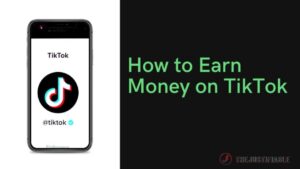Table of Contents
Are you struggling to find an online marketing strategy that guarantees results? Do you want to dominate your niche but feel overwhelmed by the competition?
In this article, we’ll answer these questions and provide a fail-proof online marketing strategy designed to help you thrive in your specific market.
Proven Online Marketing Tactics for Guaranteed Success

The key to a fail-proof online marketing strategy lies in proven tactics. By mastering core elements such as SEO, social media, email marketing, and content creation, I believe you can confidently achieve long-term success in your niche.
I suggest focusing on strategies that consistently deliver results. Understanding how each component works together ensures a solid marketing foundation. Let’s explore essential techniques you can implement to start seeing measurable growth.
Mastering Search Engine Optimization (SEO) Techniques
SEO is fundamental for online visibility. I emphasize the importance of optimizing your website with targeted keywords to boost rankings. Start by researching phrases your audience searches for, and integrate them into your content naturally. This helps drive organic traffic.
I advise you to also consider on-page elements like meta tags, alt texts, and internal linking. These subtle yet impactful optimizations improve your site’s relevance. Additionally, focus on building backlinks from credible sources, which signals trustworthiness to search engines.
Local SEO is another area I recommend exploring. By optimizing your business for local searches, you can capture nearby customers. Claim your Google My Business profile and ensure your contact details are consistent across platforms.
Finally, regularly analyze your site’s performance. Use tools to monitor metrics like bounce rate, keyword rankings, and organic traffic. Adjust your SEO tactics accordingly, and you’ll stay ahead of competitors.
Leveraging Social Media for Increased Engagement
Social media plays a powerful role in brand awareness. I recommend sharing valuable content that resonates with your audience, sparking engagement. Choose platforms where your target audience spends time and create a consistent posting schedule.
Experiment with different content types such as videos, infographics, and polls. Interactive content helps humanize your brand and strengthens relationships. Use hashtags strategically to increase your posts’ visibility and reach new potential followers.
I suggest incorporating social proof to build trust. Share customer testimonials or user-generated content to show credibility. You can also run social media contests or giveaways to encourage followers to engage more frequently with your brand.
Another tactic I’ve found effective is utilizing social media advertising. Platforms like Facebook and Instagram allow highly targeted ads that reach specific demographics, enhancing your online marketing strategy.
Email Marketing Strategies to Boost Conversions
Email marketing remains one of the most effective conversion tools. I believe that segmenting your email list helps deliver personalized content to the right people. This increases open rates and engagement, fostering stronger customer relationships.
I suggest crafting compelling subject lines. These determine whether your emails are opened or ignored. Keep them short, action-oriented, and relevant to the recipient’s needs. A strong call-to-action within the email will drive conversions.
Another effective strategy is to automate email sequences. Automating welcome emails, product recommendations, and follow-up messages saves time while maintaining personalization. This consistent communication nurtures leads and guides them through the sales funnel.
Lastly, I advise optimizing emails for mobile. Most users check their emails on mobile devices, so ensure your messages are responsive and visually appealing. Incorporating clear, persuasive content will help you convert subscribers into loyal customers.
Effective Content Marketing for Niche Authority
Content marketing helps establish you as an authority within your niche. I suggest producing high-quality content that educates and entertains your audience. Blog posts, videos, podcasts, and infographics provide value while showcasing your expertise.
I also recommend focusing on long-tail keywords. These are more specific phrases your target audience searches for, helping you rank higher on search engines. Writing in-depth content around these keywords will attract visitors with strong intent.
Creating evergreen content is another valuable tactic. These are timeless pieces that remain relevant over time, continually driving traffic to your site. Repurpose your existing content into new formats, like turning blog posts into videos, to maximize its impact.
Lastly, I advise promoting your content across multiple channels. Share it on social media, within email newsletters, and via influencer partnerships to broaden your reach and solidify your niche authority.
How to Identify and Target Your Ideal Audience

Understanding your target audience is crucial for an effective online marketing strategy. I advise conducting thorough market research to gain insights into who your customers are. Defining your audience allows you to create tailored messages that resonate with their needs.
Once you’ve identified your ideal audience, you can focus on reaching them through targeted campaigns. Analyzing behavioral data and preferences further helps fine-tune your approach, ensuring your efforts are as effective as possible.
Conducting Market Research for Audience Insights
Market research is essential for understanding your audience’s needs and preferences. I suggest starting with surveys and polls to gather direct feedback from your existing customers. This allows you to pinpoint pain points and expectations.
I recommend using analytics tools to track audience behavior. By examining what content or products they engage with, you can adjust your marketing efforts. Use social media insights, website analytics, and competitor research to paint a full picture.
Focus groups are another helpful tool. Engaging in one-on-one discussions with potential customers provides deep insights into their motivations. You can ask about their buying habits and decision-making process, shaping your marketing strategy.
Lastly, I believe ongoing research is critical. Customer preferences evolve, so continuously monitor trends and adapt your campaigns accordingly. Staying ahead of shifts in behavior keeps your online marketing strategy relevant.
Creating Buyer Personas for Precision Targeting
Creating buyer personas helps target your marketing messages more effectively. I suggest building profiles of your ideal customers, including demographics, interests, and buying behaviors. These personas act as blueprints for crafting personalized campaigns.
For each persona, I recommend identifying specific goals and pain points. Tailor your marketing content to address these, making it more relevant. This personalized approach increases the likelihood of conversions, as it speaks directly to customer needs.
I advise using data from previous customers to shape these personas. Analyze what content they’ve engaged with, what products they’ve purchased, and how they interact with your brand. This ensures your personas are based on real behaviors.
Finally, I suggest refining personas as your business grows. As new customers come in, their behaviors may differ, requiring updates. Maintaining accurate personas ensures your online marketing strategy stays focused and impactful.
Using Behavioral Data to Optimize Campaigns
Behavioral data provides insights into how your audience interacts with your content. I recommend tracking metrics such as time on page, bounce rates, and click-through rates to understand what’s working and what needs improvement.
Analyzing customer journeys helps you identify patterns. I’ve noticed that customers often follow similar paths before converting, so focus on optimizing touchpoints. By delivering the right message at the right time, you increase the likelihood of conversion.
I suggest using remarketing tactics based on behavioral data. For example, if a visitor viewed a product but didn’t purchase, retarget them with an ad featuring that product. This gentle nudge can push them closer to making a decision.
Lastly, I advise testing different variations of your campaigns. Use A/B testing to experiment with headlines, images, and calls-to-action. The data you gather will reveal which elements drive better engagement, allowing you to optimize future efforts.
Online Marketing Tools That Streamline Your Strategy

Online marketing tools are essential to streamline your strategy and save time. I believe investing in the right tools will enhance your efficiency and help you focus on high-impact activities. These tools support SEO, social media, analytics, and email marketing.
I recommend choosing tools that suit your specific needs. The right software will simplify tasks like tracking metrics, managing campaigns, and automating repetitive tasks. With the right setup, your online marketing strategy becomes more manageable and results-driven.
SEO Tools to Boost Organic Traffic
SEO tools are crucial for driving organic traffic to your website. I suggest using tools like SEMrush or Sitechecker to track keyword rankings, analyze competitors, and identify backlink opportunities. These insights help you refine your SEO strategy for better visibility.
I also recommend Google Analytics to monitor site performance and user behavior. With detailed reports, you can see how visitors interact with your content, helping you make data-driven decisions. This leads to increased traffic and improved rankings.
Another tool I’ve found valuable is Moz for technical SEO audits. It helps identify issues like broken links, duplicate content, or slow loading times. Fixing these problems improves your website’s performance and boosts your search engine rankings.
Finally, I believe that long-tail keyword research is key. Tools like Ubersuggest or AnswerThePublic help uncover low-competition keywords that attract highly-targeted traffic. Incorporating these into your content helps you dominate niche markets.
Social Media Management Platforms for Automation
Social media management platforms save you time by automating posts and tracking engagement. I recommend Hootsuite or Buffer to schedule posts across multiple platforms, ensuring consistent content delivery without manual intervention.
I suggest using these platforms to analyze audience engagement. You’ll see what content resonates most, allowing you to refine your social media strategy for better performance. Detailed analytics help you optimize your approach to maximize reach.
I’ve also learned that automation extends beyond posting. Tools like SocialBee enable you to create evergreen content categories that recycle popular posts. This keeps your social media profiles active, even when you’re focusing on other areas.
In addition, I recommend using tools like Sprout Social to monitor brand mentions. This helps you engage with followers in real-time, respond to customer inquiries, and address feedback promptly, strengthening your online presence.
Analytics Tools for Tracking and Optimization
Analytics tools are essential for tracking your marketing efforts and optimizing campaigns. I advise using Kissmetrics to measure key metrics such as traffic sources, bounce rates, and conversion rates. This data helps you refine your marketing strategy.
I also recommend tools like Hotjar to track user behavior on your website. Heatmaps and session recordings provide insight into how visitors interact with your content, helping you identify areas for improvement and enhance user experience.
For deeper campaign tracking, I suggest HubSpot or Marketo. These tools integrate with your email, social media, and content marketing efforts, offering detailed reports on campaign performance. This unified view makes optimization much easier.
Finally, I highlight the value of automation in analytics. Tools like Databox consolidate data from multiple sources into a single dashboard, providing a clear overview of performance. This streamlines decision-making and improves your marketing effectiveness.
Email Marketing Automation for Efficiency
Email marketing automation tools can significantly boost your efficiency. I suggest platforms like Moosend or ActiveCampaign to automate campaigns, segment your audience, and personalize content based on user behavior. This targeted approach improves engagement.
I recommend setting up automated sequences such as welcome emails, cart abandonment reminders, and product recommendations. These nurture leads through the sales funnel, increasing your chances of conversion without manual effort.
Another tactic I’ve found effective is A/B testing within email campaigns. Tools like ConvertKit allow you to test subject lines, design, and content variations. Optimizing your emails ensures higher open and click-through rates, leading to better results.
Finally, I believe tracking email performance is crucial. Platforms like Sendinblue provide detailed reports on delivery rates, bounce rates, and conversion metrics. This data allows you to refine future campaigns for even better performance.
Importance of Analytics and Measuring Success
I emphasize that measuring your marketing efforts is critical for long-term success. Analytics provide the data needed to understand what’s working and what needs improvement. I suggest regularly reviewing key metrics to stay on top of your online marketing performance.
By tracking and analyzing your results, you gain valuable insights into customer behavior, campaign effectiveness, and overall return on investment. I recommend using these insights to continually optimize and enhance your strategy.
Tracking Key Performance Indicators (KPIs)
KPIs help measure your marketing success. I recommend tracking metrics like conversion rates, traffic, and lead generation to understand which strategies are most effective. Monitoring these key indicators helps you stay on track toward your goals.
I also advise setting specific, measurable targets for each KPI. Whether it’s increasing website visits or boosting social media engagement, having clear goals ensures your efforts remain focused and results-driven.
Another tip I’ve learned is to frequently review your KPIs. Regular analysis allows you to spot trends and adjust your strategy as needed. Staying proactive ensures that you can quickly address any underperforming areas.
Lastly, I believe KPIs should align with your broader business objectives. Whether aiming for growth, lead nurturing, or brand awareness, your chosen metrics should reflect your overall strategy and vision for success.
Using A/B Testing for Marketing Campaign Improvement
A/B testing is a valuable method for improving your marketing campaigns. I suggest experimenting with different elements of your ads, emails, or landing pages to see which version performs better. Testing allows you to optimize content for better results.
I recommend starting small by testing headlines or subject lines. These often have a big impact on user engagement. By analyzing which version resonates more with your audience, you can refine future campaigns for higher effectiveness.
I also advise tracking user behavior during tests. Pay attention to metrics like click-through rates and conversions to determine which elements drive better engagement. This data ensures your A/B testing efforts lead to meaningful improvements.
Finally, I believe it’s important to continually test and refine. Even small changes can yield significant results over time. A commitment to ongoing optimization ensures your campaigns remain relevant and impactful.
Understanding Conversion Rates and ROI
Conversion rates and ROI are key indicators of your campaign’s success. I advise calculating your conversion rate to understand how well your marketing efforts turn leads into customers. This helps gauge the effectiveness of your overall strategy.
I recommend using tools like Google Analytics or HubSpot to track conversions across different channels. Understanding which campaigns deliver the highest return enables you to allocate resources more effectively.
Additionally, I believe ROI should always be top of mind. Assess the cost of your campaigns versus the revenue they generate. This allows you to determine which efforts provide the best return, ensuring your marketing budget is spent wisely.
Lastly, I suggest continually optimizing for better conversion rates. From tweaking your call-to-action to refining audience targeting, small changes can lead to increased conversions and a higher ROI over time.
Scaling Your Online Marketing Efforts for Growth
Scaling your online marketing strategy is essential for sustained growth. I advise expanding your efforts by exploring new channels, leveraging automation, and partnering with influencers. This helps you reach a larger audience and drive long-term success.
As your business grows, I recommend regularly assessing your marketing strategy to ensure it adapts to new opportunities. Scaling strategically helps you stay ahead of the competition while maintaining a strong connection with your audience.
Expanding Your Audience with Paid Advertising
Paid advertising is an effective way to expand your audience quickly. I suggest using platforms like Google Ads or Facebook Ads to target specific demographics. This allows you to reach potential customers beyond your organic reach.
I recommend starting with small budgets and testing different ad creatives. Track performance metrics like click-through rates and conversions to understand which ads resonate with your audience. Gradually increase spending as you see results.
Another approach I advise is remarketing. Display ads to users who’ve previously visited your site but didn’t convert. This keeps your brand top-of-mind and increases the chances of future conversions.
Lastly, I believe in combining paid and organic efforts. While ads help you scale quickly, maintaining a strong organic presence ensures long-term sustainability and brand authority.
Partnering with Influencers for Wider Reach
Influencer partnerships are a powerful way to grow your audience. I recommend collaborating with influencers who align with your brand values and target audience. Their endorsement helps build trust and extends your reach to their followers.
I suggest starting by identifying influencers within your niche. Reach out with personalized pitches, emphasizing the mutual benefits of collaboration. A genuine partnership increases the likelihood of long-term success.
I’ve seen that influencers can drive engagement in multiple ways, from sponsored posts to product reviews. Leverage these different content types to keep your audience engaged and drive more traffic to your brand.
Lastly, I advise measuring the results of your influencer campaigns. Track engagement, clicks, and conversions to assess their impact. This helps ensure your partnerships are delivering the expected return.
Repurposing Content for Multi-Channel Promotion
Repurposing content is an efficient way to maximize your marketing efforts. I suggest transforming blog posts into videos, podcasts, or infographics to reach a broader audience across different platforms. This allows you to extend the life of your content.
I recommend focusing on high-performing content. Identify blog posts or social media posts that resonate well with your audience and repurpose them into new formats. This helps reinforce your messaging and attract new followers.
Another tactic I advise is adapting content for different channels. For example, a detailed blog post can be broken down into bite-sized tips for Instagram or Twitter. This ensures your message stays fresh and engaging across platforms.
Finally, I believe consistency is key. Repurposing content allows you to maintain a steady flow of valuable information, helping you scale your online marketing efforts without needing to constantly create new material.






